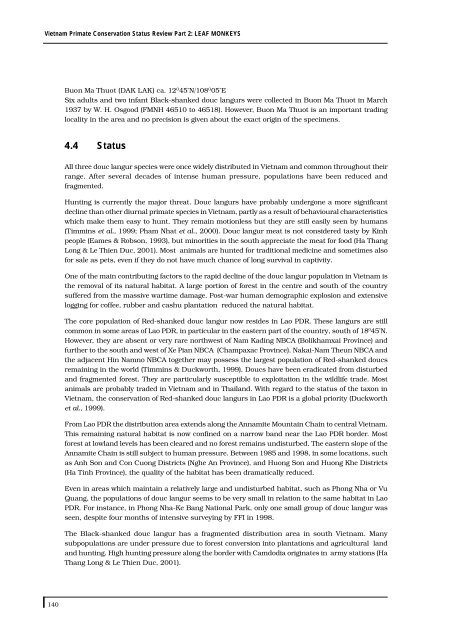Vietnam Primate Conservation Status Review 2002 - Hoang Lien ...
Vietnam Primate Conservation Status Review 2002 - Hoang Lien ...
Vietnam Primate Conservation Status Review 2002 - Hoang Lien ...
Create successful ePaper yourself
Turn your PDF publications into a flip-book with our unique Google optimized e-Paper software.
<strong>Vietnam</strong> <strong>Primate</strong> <strong>Conservation</strong> <strong>Status</strong> <strong>Review</strong> Part 2: LEAF MONKEYS<br />
140<br />
Buon Ma Thuot (DAK LAK) ca. 12 O 45’N/108 O 05’E<br />
Six adults and two infant Black-shanked douc langurs were collected in Buon Ma Thuot in March<br />
1937 by W. H. Osgood (FMNH 46510 to 46518). However, Buon Ma Thuot is an important trading<br />
locality in the area and no precision is given about the exact origin of the specimens.<br />
4.4 <strong>Status</strong><br />
All three douc langur species were once widely distributed in <strong>Vietnam</strong> and common throughout their<br />
range. After several decades of intense human pressure, populations have been reduced and<br />
fragmented.<br />
Hunting is currently the major threat. Douc langurs have probably undergone a more significant<br />
decline than other diurnal primate species in <strong>Vietnam</strong>, partly as a result of behavioural characteristics<br />
which make them easy to hunt. They remain motionless but they are still easily seen by humans<br />
(Timmins et al., 1999; Pham Nhat et al., 2000). Douc langur meat is not considered tasty by Kinh<br />
people (Eames & Robson, 1993), but minorities in the south appreciate the meat for food (Ha Thang<br />
Long & Le Thien Duc, 2001). Most animals are hunted for traditional medicine and sometimes also<br />
for sale as pets, even if they do not have much chance of long survival in captivity.<br />
One of the main contributing factors to the rapid decline of the douc langur population in <strong>Vietnam</strong> is<br />
the removal of its natural habitat. A large portion of forest in the centre and south of the country<br />
suffered from the massive wartime damage. Post-war human demographic explosion and extensive<br />
logging for coffee, rubber and cashu plantation reduced the natural habitat.<br />
The core population of Red-shanked douc langur now resides in Lao PDR. These langurs are still<br />
common in some areas of Lao PDR, in particular in the eastern part of the country, south of 18 0 45’N.<br />
However, they are absent or very rare northwest of Nam Kading NBCA (Bolikhamxai Province) and<br />
further to the south and west of Xe Pian NBCA (Champaxac Province). Nakai-Nam Theun NBCA and<br />
the adjacent Hin Namno NBCA together may possess the largest population of Red-shanked doucs<br />
remaining in the world (Timmins & Duckworth, 1999). Doucs have been eradicated from disturbed<br />
and fragmented forest. They are particularly susceptible to exploitation in the wildlife trade. Most<br />
animals are probably traded in <strong>Vietnam</strong> and in Thailand. With regard to the status of the taxon in<br />
<strong>Vietnam</strong>, the conservation of Red-shanked douc langurs in Lao PDR is a global priority (Duckworth<br />
et al., 1999).<br />
From Lao PDR the distribution area extends along the Annamite Mountain Chain to central <strong>Vietnam</strong>.<br />
This remaining natural habitat is now confined on a narrow band near the Lao PDR border. Most<br />
forest at lowland levels has been cleared and no forest remains undisturbed. The eastern slope of the<br />
Annamite Chain is still subject to human pressure. Between 1985 and 1998, in some locations, such<br />
as Anh Son and Con Cuong Districts (Nghe An Province), and Huong Son and Huong Khe Districts<br />
(Ha Tinh Province), the quality of the habitat has been dramatically reduced.<br />
Even in areas which maintain a relatively large and undisturbed habitat, such as Phong Nha or Vu<br />
Quang, the populations of douc langur seems to be very small in relation to the same habitat in Lao<br />
PDR. For instance, in Phong Nha-Ke Bang National Park, only one small group of douc langur was<br />
seen, despite four months of intensive surveying by FFI in 1998.<br />
The Black-shanked douc langur has a fragmented distribution area in south <strong>Vietnam</strong>. Many<br />
subpopulations are under pressure due to forest conversion into plantations and agricultural land<br />
and hunting. High hunting pressure along the border with Camdodia originates in army stations (Ha<br />
Thang Long & Le Thien Duc, 2001).



